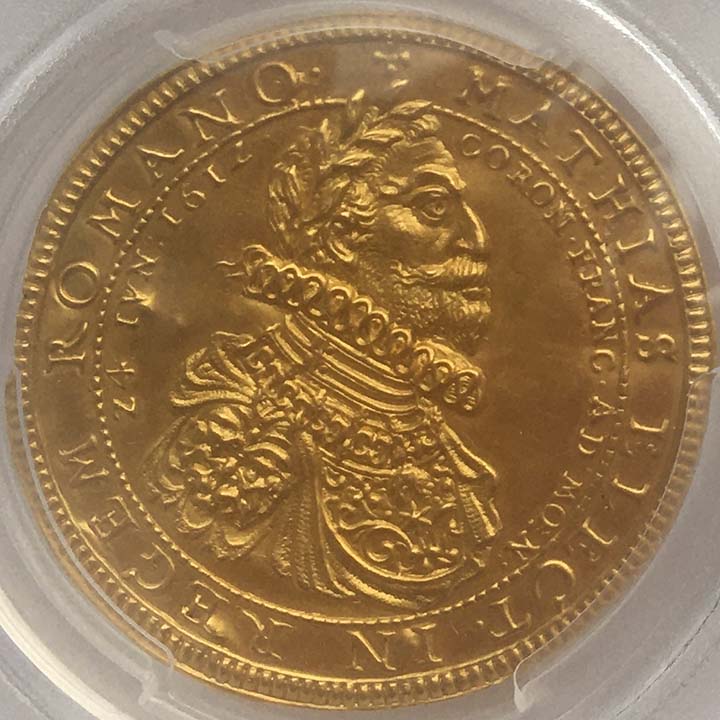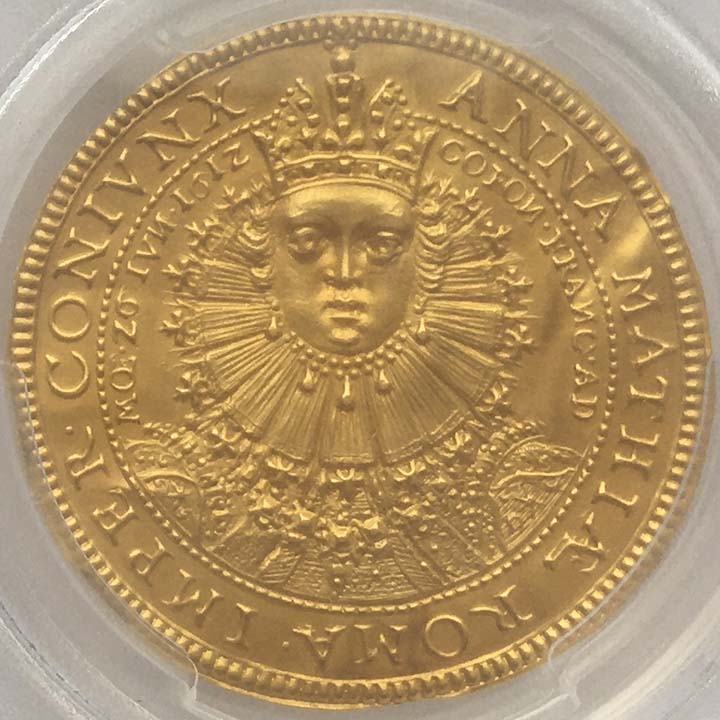Gold Obverse Trial Strikes
World-Class Numismatic Rarity
Matthias II - Holy Roman Emperor
c.1612 Gold Coronation Medals
Matthias II and Anna
German States - Frankfurt am Main
Listed & Illustrated in Forschner
PCGS MS65 and MS64
1 of Only 2 Known Sets
SOLD


This historical museum quality set of gold Coronation Die Trial Strikes was authenticated and certified by PCGS and is one of only two known sets. It is amazing that after 400 years, these gold Die Trials remained together, intact and preserved in gem mint state condition. They are both 5 Ducat size in diameter, 39 mm and 37 mm.
These die trials were struck on very thin gold planchets. Ron Guth is a consultant to Mint Error News, a former PCGS President, and founder of CoinFacts (now PCGS CoinFacts). Currently Ron serves as proprietor of GermanCoins.com and as Chief Investigator at the Numismatic Detective Agency, where he provides expert provenance on high-end coins. Upon reviewing these die trials, he stated that:
"I suspect that your die trials were made by striking a thin piece of gold laid on a softer material such as leather. This would account for some of the waviness in the planchets."The British Museum has a similar and extremely rare Gold Coronation Medal that they describe as a cliche. Struck in 1658, in Austria/Hungary, this medal has a diameter of 42 mm and commemorates Leopold I as the Holy Roman Emperor. It is in magnificent condition and is a historical numismatic rarity on par with these Matthias II Gold Obverse Trial Strikes.
The Matthias II Obverse Trial Strike is listed and illustrated in Forschner as #34.1 gold, with a diameter of 39 mm and a weight of 2.49 grams. The other Die Trial of his wife Anna, is also listed and illustrated in Forschner as #34.3 gold, with a diameter of 37 mm and a weight of 2.31 grams. The Forschner numismatic reference book on medals is referenced by both PCGS and NGC for attribution and listing the Forschner # on the inserts.
Matthias II of Austria (Feb 24, 1557- March 20, 1619) was crowned King of Hungary and Croatia in 1608. He was also King of Bohemia in 1611, as well as the Archduke of Austria. He was Head of the House of Hasburg.
Matthias II reigned from June 13, 1612 to March 20, 1619 as the Holy Roman Emperor. These gold obverse die trials commemorate his Coronation, and likely were presented to Matthias for his approval prior to striking the Coronation medals. No known medals were struck with this design. It's unbelievable that after centuries of war, barbaric times and world instability, these even exist today!
The Electors, located in Frankfurt am Main, Germany but part of the Roman Empire at that time, authorized and minted coins and medals to celebrate Coronations and the accession to the position of Holy Roman Emperor. Frankfurt am Main was a free City and only accountable to the Holy Roman Emperor. The Monarch who would receive the Coronation at the hands of the Pope was elected by the Electors.
In 1618, during the last year of Matthias reign as the Holy Roman Emperor, the Thirty Years War broke out in Europe, lasting until 1648. It was one of the most destructive wars in history, starting as a war between Protestants and Catholics but evolved into a major European full-scale war resulting in millions of deaths and transforming Europe. The Holy Roman Empire eventually became what is known as Austria and Hungary today.
In Freidberg, under Germany Frankfurt am Main, gold coins from 1612-1618 during the short reign of Matthias II (Freidberg #947-957) are designated as very rare and unpriced.
In The Standard Catalog of World Coins (Krause) the ND 1612 Matthias 3 Ducat (KM #43) is listed as rare and unpriced. The 5 Ducat (KM #44) is also listed as rare and unpriced.
Gold Coins of Matthias II are extremely rare in the larger denominations such as the 5 Ducat and 10 Ducat. Coronation Medals of Matthias II struck in gold are even rarer. Many of these are often damaged and heavily worn, selling in the $20K to $60K range in public auctions.
Stacks Bowers sold a German State Frankfurt am Main 5 Ducat ND 1612 commemorating the election of Matthias as the Holy Roman Emperor. It was 32.2 MM, 2 known, realizing $60,000. in VF condition, with damage, graffiti in the obverse fields. In another Stacks Bowers auction, they sold an Austria Vienna 10 Ducat, 32.8 MM, of Matthias 1612 in EF condition, uncertified, realizing $23,000 with damage, 2 carved X's in the obverse fields.
Recently in a Kunker German Coin Auction, a non damaged 10 Ducat 1619 of Matthias II from Vienna, Austria in good - very fine condition, not certified by PCGS or NGC, sold for approximately $164,650. In an April 2024 Macho & Chlapovič auction, a Matthias II Gold Medal (20 Ducats) sold for $321,371.
In the March 2021 Heritage auction of The Paramount Collection, a Matthias II "Three Emperors" 5 Ducat from the Prague Mint, certified MS63 by NGC, for $408,000.  Also in the same sale, a 10 Ducat 1612 of Matthias II from Vienna, Austria, certified MS62 by NGC, sold for $204,000.   Images courtesy of Heritage Auctions |
Very few gold medals of Coronations of European Kings, have the fascination and excitement of these 2 gold Obverse Die Trials. Additionally, in this case they also celebrate Matthias' rise to be the Holy Roman Emperor. They are historically significant and numismatically important since they document a Coronation and accession to the position of Holy Roman Emperor.
These PCGS certified Matthias Gold Obverse Die Trial strikes defy logic and history, both surviving 400 years in gem condition. They belong in the finest collection of European gold coins, in a world-class collection of numismatic treasures, or in a major Museum showcasing their history and significance.












These are both illustrated in the Forschner reference book:



Featured on the cover of Mint Error News Magazine Issue 54:

Frankfurt in 1612

Matthias II |
Assession to Holy Roman Emperor |
Die Trials are featured in chapter 13
of my NLG Award winning book, World's Greatest Mint Errors:





